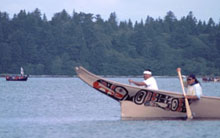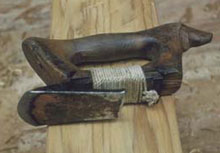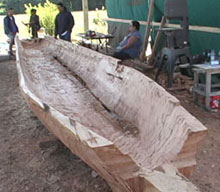
Just months prior to Tribal Journeys, Spirit of Elwha, makes its own journey. Click image for larger view and image credit.
Northwestern Seagoing Canoe
It is the astonishing development of technology that enables humans to navigate and understand the oceans. Water is a substance toxic to our systems if we breathe it. It is elementally foreign to the processes of physical adaptation by which the human body evolved. It is hostile as an environment. The water world is forever unapproachable without the intervention of technology—boats and ships, airtight diving vessels, propulsion and navigation systems, communication tools and ways to acquire information. And beyond the impulse to explore new places, travel and survive, humans need to understand the oceans—to discover basic ocean processes, assess life in the ocean upon which our lives depend and measure our impacts on what turns out to be a vast and frail ecosystem.
Ocean exploration is not limited to mapping the coastlines and currents or to the acquisition of data or images. The sea remains a vast territory for the extension of the human experience and our reconnection to our places on the planet. We explore the ocean to explore our own past, as a species or as societies whose histories are linked to the sea. Today Northwest Coast First Nations and Indian Tribes are venturing on such a quest with the rebirth of the canoe culture and the reawakening of old ways. The journeys are literal and figurative—in exploring the ancient shores and ancient villages, elders and youth alike explore their inner-most being. Tuning the fine balance as Native Americans and inhabitants of a very modern world, their vessel is the canoe. The technology of their journey is as ancient as it is sophisticated.
Cedar
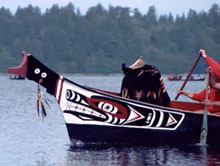
A Coast Salish design embodied in Raven Spirit of the Suquamish Tribe. Click image for larger view and image credit.
The great ocean canoe is made from a single trunk of Western red cedar (Thuja plicata). Cedar is prized because of its strength, lightness, ease of splitting and working, buoyancy and resistance to rot. With the evolution of the Northwest coastal maritime climate about 6,000 years ago, cedar trees became co-dominant members of the lowland coastal forest. Today, they are symbolic of the “old-growth” forest, a habitat greatly diminished because of logging over the last century. Reaching 8 to 10 feet at the base and up to 200 feet in height, a red cedar tree is a rich source of raw material. Its bark and inner bark can be transformed into fiber for baskets and fabric; its fibrous roots can be woven and knotted into cordage. The wood itself is light and even-grained, making it ideal for splitting into planks and stakes, as well as for carved objects as small as combs and as large as canoes and house posts. Traditionally, large planks could be split from living trees, with the rot-resistant sap quickly scarring and healing the tree. Downed logs can persist on the ground or on beaches for decades without rotting because of potent natural pesticides in the tree’s volatile oils.
Canoe Design
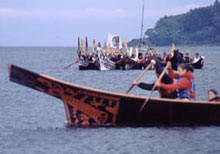
A Coast Salish design embodied in Raven Spirit of the Suquamish Tribe. Click image for larger view and image credit.
Northwest canoes follow traditional designs based on function, marine conditions and culture. Typically, ocean canoes differ from river canoes in their generous proportion and sweeping bow and stern, adaptations to wave and swell. Functionally, canoes vary in size: a sealing canoe requires a smaller craft and navigates closer in-shore than a whaler. Canoes for fishing or local travel might be handled solo or in very shallow conditions. Canoes designed for high wave and swell conditions demonstrate the ability to rock lengthwise, with long prows and high sterns to ward off large seas. Sheer mass and trim lines keep the canoe on track and allow it to cut through waves.
Early observers noted three main types of canoe designs, based on culture and regional geography. The three main designs are: Nuu-Chah-Nulth (sometimes called “West Coast” or “Chinook”); Coast Salish; and Yakutat (sometimes called “Northern-style”).
The “Nuu-Chah-Nulth” style has a characteristic long prow, formed to resemble the head of a wolf or deer. Its snout points forward, with the space between the “ears” forming a notch to hold a stowed mast or harpoon. The stern is typically blunt, a vertical block with a slight back rest. Nuu-Chah-Nulth lines are long and trim, that give the canoe a sleek and fast look. Many are simply painted or finished in black. These canoes are commonly used among Pacific Coast tribes like the Quinault, Quileute, Hoh and Makah, as well as the Makah’s northern relatives of Vancouver Island’s west coast, the Nuu-chah-nulth.
The “Coast Salish” style is common among the inner waters of the Strait of Georgia, Strait of Juan de Fuca and Puget Sound. The Coast Salish design typically consists of a thicker, heavier prow, giving the bow more of the appearance of a long, broad blade cutting the water. Many prows are notched prominently at the end, looking like the gape of an animal’s mouth. Often, the Coast Salish canoe is black, with elaborate ochre or red stylized figures near the bow. These canoes are common among Salishan language-based tribes of the more protected inland seas.“Yakutat,” or “Northern-style” canoes include a variety of design forms, including a characteristic curve and swelling near the bow. The prow of the canoe gracefully curves up from the water and can be adorned by elaborate carvings. This style gives the canoe the ability to rock over waves, rising majestically with each swell. Decoration can be very elaborate. These canoes were developed by northern people, including the Tlingit, Haida, Tsimshian and Kwakiutl of extreme northern Vancouver Island, the Queen Charlotte Islands (Gwai Haanas) and present-day Southeast Alaska.
Canoe Construction
The ocean canoe hull is fashioned from a single cedar tree. Today, as in the past,the log is shaped into a rough blank on the outside, then rolled and hollowed on the inside. Separately carved bow and stern pieces add height and length to the canoe. Once the sides and bottom are thinned to the proper dimension, the canoe is soaked and steamed so that the sides can be stretched to the canoe’s full width and held apart by the thwarts, or seat boards. Today, chainsaws and other power tools are used for canoe building. Logs are trucked from remote logging sites or where they have been salvaged. Yet in spite of a new ease of working wood with power tools, the work of canoe building is mastered by only a few people. Skills are honed over time as carvers practice endlessly on smaller models, training their eyes and hands to execute the critical lines on a larger scale. Detail work requires skilled fitting and joining. Finishing requires skill with traditional adze and curved knife. Finally, decorating the canoe requires the artist’s skill a composing and painting the traditional art forms that represent people, and creatures of forest, sea and sky that adorn the canoe. At its naming ceremony, the canoe receives a traditional blessing. Prayers and sage smoke rise above the transformed log as the new ocean being is welcomed into the community. Paddles and other tools Cedar finds its way into other tools of the canoe. Carved bailers are used to scoop seawater out of the vessel. Canoe paddles can be fashioned out of red cedar, or its relative, yellow cedar. Stronger and denser than red cedar, yellow cedar shares the property of rot resistance. A bright white or pale lemon in color, yellow cedar paddles are often painted with black and ochre patterns.
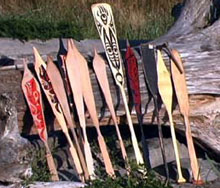
Paddles, the tool of the puller. Image courtesy of Robert Steelquist, OCNMS
Many canoe pullers carve their own paddles, sanding and shaping right up to the beginning of the journey. Shapes vary with tradition and tribe, but most have a sharp lance-like blade. Whalers’ paddles taper to a fine point, so they enter the water more quietly and guide the drips of water off in a stream. The great steering paddle is very stout and broad so the skipper can either paddle or use the broad surface as a lever against the flowing water, held tightly under the elbow and worked against one side or the other at the stern of the canoe.
The great ocean canoes reside at that nexus between technology and living beings. Their great hulls are once-living trees, vast living tissues that survived centuries and sustained the lives of innumerable birds, insects, mammals and other plants. With painstaking precision, the trees were transformed into the vessels of the people. Without drawings, without calculations, without engineering as we now know it, journey carvers and now-forgotten artists formed the mighty logs into living sea craft. Blessed at each step of their transformation and hardened by the forces of water, the canoes came to represent whole communities. And in the canoe journeys, the canoe almost leads its crew along, it’s own journey of a thousand years or more the exemplar of unity and power, of daunting persistence and spiritual transport. It is a technology older than time and still perfectly fitting for people seeking to explore and know the ocean.
(top)









